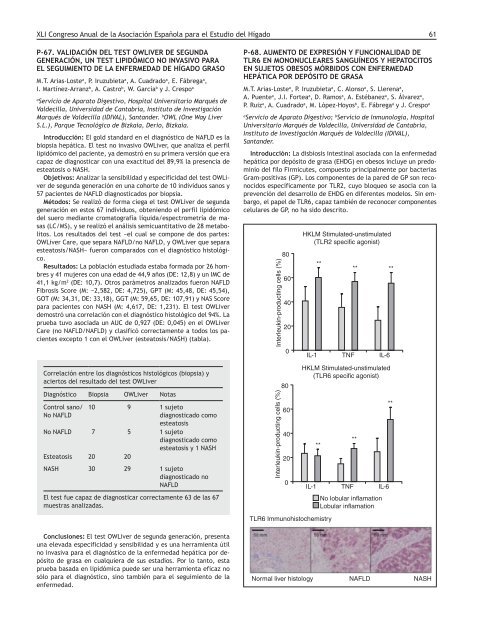XLI Congreso Anual de la Asociación Española para el Estudio del Hígado
R1T9He
R1T9He
You also want an ePaper? Increase the reach of your titles
YUMPU automatically turns print PDFs into web optimized ePapers that Google loves.
Interleukin-producting c<strong>el</strong>ls (%)<br />
Interleukin-producting c<strong>el</strong>ls (%)<br />
<strong>XLI</strong> <strong>Congreso</strong> <strong>Anual</strong> <strong>de</strong> <strong>la</strong> <strong>Asociación</strong> Españo<strong>la</strong> <strong>para</strong> <strong>el</strong> <strong>Estudio</strong> <strong>de</strong>l <strong>Hígado</strong> 61<br />
P-67. VALIDACIÓN DEL TEST OWLIVER DE SEGUNDA<br />
GENERACIÓN, UN TEST LIPIDÓMICO NO INVASIVO PARA<br />
EL SEGUIMIENTO DE LA ENFERMEDAD DE HÍGADO GRASO<br />
M.T. Arias-Loste a , P. Iruzubieta a , A. Cuadrado a , E. Fábrega a ,<br />
I. Martínez-Arranz b , A. Castro b , W. García b y J. Crespo a<br />
a<br />
Servicio <strong>de</strong> A<strong>para</strong>to Digestivo, Hospital Universitario Marqués <strong>de</strong><br />
Val<strong>de</strong>cil<strong>la</strong>, Universidad <strong>de</strong> Cantabria, Instituto <strong>de</strong> Investigación<br />
Marqués <strong>de</strong> Val<strong>de</strong>cil<strong>la</strong> (IDIVAL), Santan<strong>de</strong>r. b OWL (One Way Liver<br />
S.L.), Parque Tecnológico <strong>de</strong> Bizkaia, Derio, Bizkaia.<br />
Introducción: El gold standard en <strong>el</strong> diagnóstico <strong>de</strong> NAFLD es <strong>la</strong><br />
biopsia hepática. El test no invasivo OWLiver, que analiza <strong>el</strong> perfil<br />
lipidómico <strong>de</strong>l paciente, ya <strong>de</strong>mostró en su primera versión que era<br />
capaz <strong>de</strong> diagnosticar con una exactitud <strong>de</strong>l 89,9% <strong>la</strong> presencia <strong>de</strong><br />
esteatosis o NASH.<br />
Objetivos: Analizar <strong>la</strong> sensibilidad y especificidad <strong>de</strong>l test OWLiver<br />
<strong>de</strong> segunda generación en una cohorte <strong>de</strong> 10 individuos sanos y<br />
57 pacientes <strong>de</strong> NAFLD diagnosticados por biopsia.<br />
Métodos: Se realizó <strong>de</strong> forma ciega <strong>el</strong> test OWLiver <strong>de</strong> segunda<br />
generación en estos 67 individuos, obteniendo <strong>el</strong> perfil lipidómico<br />
<strong>de</strong>l suero mediante cromatografía líquida/espectrometría <strong>de</strong> masas<br />
(LC/MS), y se realizó <strong>el</strong> análisis semicuantitativo <strong>de</strong> 28 metabolitos.<br />
Los resultados <strong>de</strong>l test −<strong>el</strong> cual se compone <strong>de</strong> dos partes:<br />
OWLiver Care, que se<strong>para</strong> NAFLD/no NAFLD, y OWLiver que se<strong>para</strong><br />
esteatosis/NASH− fueron com<strong>para</strong>dos con <strong>el</strong> diagnóstico histológico.<br />
Resultados: La pob<strong>la</strong>ción estudiada estaba formada por 26 hombres<br />
y 41 mujeres con una edad <strong>de</strong> 44,9 años (DE: 12,8) y un IMC <strong>de</strong><br />
41,1 kg/m 2 (DE: 10,7). Otros parámetros analizados fueron NAFLD<br />
Fibrosis Score (M: −2,582, DE: 4,725), GPT (M: 45,48, DE: 45,54),<br />
GOT (M: 34,31, DE: 33,18), GGT (M: 59,65, DE: 107,91) y NAS Score<br />
<strong>para</strong> pacientes con NASH (M: 4,617, DE: 1,231). El test OWLiver<br />
<strong>de</strong>mostró una corre<strong>la</strong>ción con <strong>el</strong> diagnóstico histológico <strong>de</strong>l 94%. La<br />
prueba tuvo asociada un AUC <strong>de</strong> 0,927 (DE: 0,045) en <strong>el</strong> OWLiver<br />
Care (no NAFLD/NAFLD) y c<strong>la</strong>sificó correctamente a todos los pacientes<br />
excepto 1 con <strong>el</strong> OWLiver (esteatosis/NASH) (tab<strong>la</strong>).<br />
Corre<strong>la</strong>ción entre los diagnósticos histológicos (biopsia) y<br />
aciertos <strong>de</strong>l resultado <strong>de</strong>l test OWLiver<br />
Diagnóstico Biopsia OWLiver Notas<br />
Control sano/<br />
No NAFLD<br />
10 9 1 sujeto<br />
diagnosticado como<br />
esteatosis<br />
No NAFLD 7 5 1 sujeto<br />
diagnosticado como<br />
esteatosis y 1 NASH<br />
Esteatosis 20 20<br />
NASH 30 29 1 sujeto<br />
diagnosticado no<br />
NAFLD<br />
El test fue capaz <strong>de</strong> diagnosticar correctamente 63 <strong>de</strong> <strong>la</strong>s 67<br />
muestras analizadas.<br />
Conclusiones: El test OWLiver <strong>de</strong> segunda generación, presenta<br />
una <strong>el</strong>evada especificidad y sensibilidad y es una herramienta útil<br />
no invasiva <strong>para</strong> <strong>el</strong> diagnóstico <strong>de</strong> <strong>la</strong> enfermedad hepática por <strong>de</strong>pósito<br />
<strong>de</strong> grasa en cualquiera <strong>de</strong> sus estadios. Por lo tanto, esta<br />
prueba basada en lipidómica pue<strong>de</strong> ser una herramienta eficaz no<br />
sólo <strong>para</strong> <strong>el</strong> diagnóstico, sino también <strong>para</strong> <strong>el</strong> seguimiento <strong>de</strong> <strong>la</strong><br />
enfermedad.<br />
P-68. AUMENTO DE EXPRESIÓN Y FUNCIONALIDAD DE<br />
TLR6 EN MONONUCLEARES SANGUÍNEOS Y HEPATOCITOS<br />
EN SUJETOS OBESOS MÓRBIDOS CON ENFERMEDAD<br />
HEPÁTICA POR DEPÓSITO DE GRASA<br />
M.T. Arias-Loste a , P. Iruzubieta a , C. Alonso a , S. Llerena a ,<br />
A. Puente a , J.I. Fortea a , D. Ramos a , A. Estébanez a , S. Álvarez a ,<br />
P. Ruiz a , A. Cuadrado a , M. López-Hoyos b , E. Fábrega a y J. Crespo a<br />
a<br />
Servicio <strong>de</strong> A<strong>para</strong>to Digestivo; b Servicio <strong>de</strong> Inmunología, Hospital<br />
Universitario Marqués <strong>de</strong> Val<strong>de</strong>cil<strong>la</strong>, Universidad <strong>de</strong> Cantabria,<br />
Instituto <strong>de</strong> Investigación Marqués <strong>de</strong> Val<strong>de</strong>cil<strong>la</strong> (IDIVAL),<br />
Santan<strong>de</strong>r.<br />
Introducción: La disbiosis intestinal asociada con <strong>la</strong> enfermedad<br />
hepática por <strong>de</strong>pósito <strong>de</strong> grasa (EHDG) en obesos incluye un predominio<br />
<strong>de</strong>l filo Firmicutes, compuesto principalmente por bacterias<br />
Gram-positivas (GP). Los componentes <strong>de</strong> <strong>la</strong> pared <strong>de</strong> GP son reconocidos<br />
específicamente por TLR2, cuyo bloqueo se asocia con <strong>la</strong><br />
prevención <strong>de</strong>l <strong>de</strong>sarrollo <strong>de</strong> EHDG en diferentes mo<strong>de</strong>los. Sin embargo,<br />
<strong>el</strong> pap<strong>el</strong> <strong>de</strong> TLR6, capaz también <strong>de</strong> reconocer componentes<br />
c<strong>el</strong>u<strong>la</strong>res <strong>de</strong> GP, no ha sido <strong>de</strong>scrito.<br />
80<br />
60<br />
40<br />
20<br />
0<br />
80<br />
60<br />
40<br />
20<br />
0<br />
**<br />
TLR6 Immunohistochemistry<br />
HKLM Stimu<strong>la</strong>ted-unstimu<strong>la</strong>ted<br />
(TLR2 specific agonist)<br />
** **<br />
IL-1 TNF IL-6<br />
HKLM Stimu<strong>la</strong>ted-unstimu<strong>la</strong>ted<br />
(TLR6 specific agonist)<br />
**<br />
IL-1 TNF IL-6<br />
Normal liver histology NAFLD NASH<br />
**<br />
No lobu<strong>la</strong>r inf<strong>la</strong>mation<br />
Lobu<strong>la</strong>r inf<strong>la</strong>mation<br />
**


